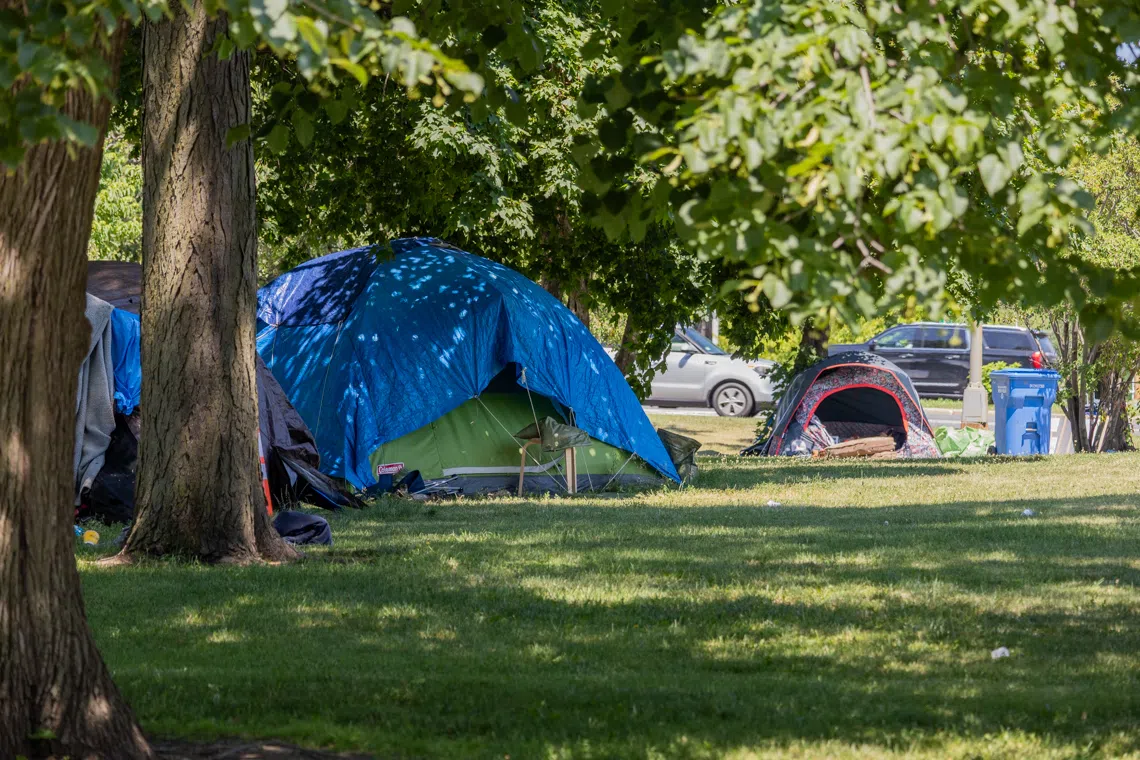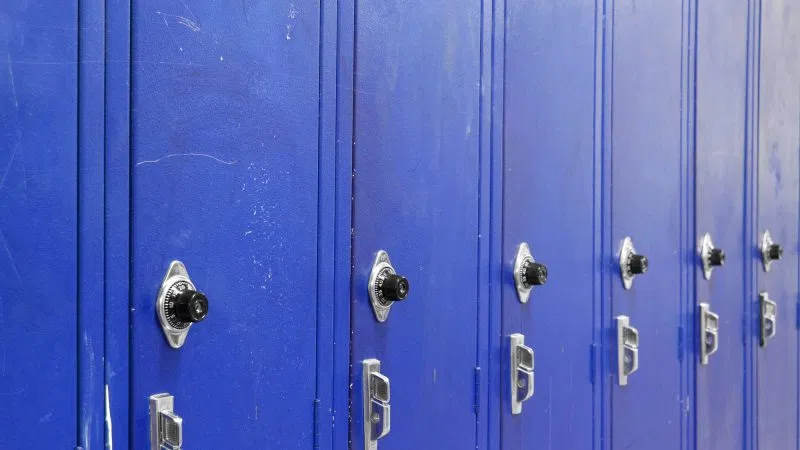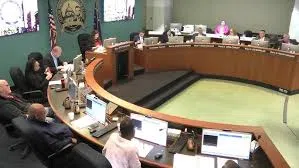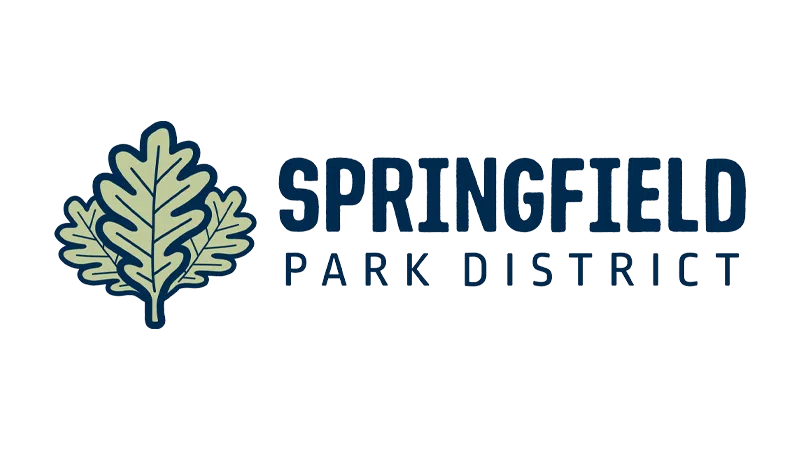By BEN SZALINSKI
Capitol News Illinois
bszalinski@capitolnewsillinois.com
Article Summary
-
Illinois’ fiscal year 2026 budget reduced funding for programs serving homeless people by more than $14 million from the previous year.
-
Gov. JB Pritzker’s “Home Illinois” initiative aimed at reaching “functional zero” homelessness saw a $26.6 million cut.
-
That program was launched in 2022 and had previously been on a steady upward funding trend.
-
Advocates worry the reductions and potential federal cuts will exacerbate homelessness in Illinois, which increased 116% in 2024, according to state data.
This summary was written by the reporters and editors who worked on this story.
The number of homeless people in Illinois is rising, but the state’s spending on homeless prevention and other housing programs is headed in the other direction.
Facing a tight budget year with constrained spending and limited natural revenue growth, the $55.1 billion fiscal year 2026 budget that took effect July 1 reduces total funding for housing programs by more than $14 million, including Pritzker’s signature initiative designed to eliminate homelessness in Illinois.
“Last year homelessness increased 116% in the state of Illinois,” Doug Kenshol, co-founder of the Illinois Shelter Alliance, told Capitol News Illinois. “To be in the midst of this crisis and then have the state cut funding was beyond disappointing.”
Discretionary spending rose by less than 1% in the FY26 budget, according to the governor’s office, despite total spending increasing by $2 billion. That minimal spending growth led lawmakers to reduce several programs.
“Is it enough? No, it isn’t … we know that homelessness is an existential crisis, and the state of Illinois takes this seriously,” Sen. Adriane Johnson, D-Buffalo Grove, who serves on a state homeless prevention task force, told Capitol News Illinois. “We have a really bold vision for ending homelessness and we’re going to continue down that path.”
Spending reductions
Pritzker first established a task force by executive order in 2021 that would create a plan for “Home Illinois” to reduce homelessness in the state to “functional zero” — where homelessness is temporary and people without housing can quickly obtain housing resources. The executive order did not set a date for the state to reach functional zero, and funding for the Home Illinois is declining by $26.6 million in FY26.
Pritzker’s administration had previously targeted housing programs for substantial increases in recent years. The FY26 budget appropriated $263.7 million for Home Illinois, down from $290.3 million in FY25. That was a $90 million increase from FY24, when the program received $200.3 million in its first year after Pritzker signed legislation in 2023 codifying the task force and Home Illinois program.
Read more: Pritzker signs $55.1B state budget reliant on $700 million of new taxes
Among the decreased spending in Home Illinois is a $25 million reduction to the Court-Based Rental Assistance Program that provides financial aid to people facing evictions. Other programs saw steady or increased funding, including shelters, which rose to fund Chicago’s One System Initiative that integrates migrants into the city’s typical shelter system.
Spending on housing programs is also down overall, according to the advocacy group Housing Action Illinois. While some housing programs saw increases that offset reductions to Home Illinois, total spending on housing programs is down by $14.6 million in the FY26 budget, to $354 million. Pritzker’s proposed budget had called for a $7.6 million decrease.
“FY26 is largely a maintenance year for the state budget,” an Illinois Department of Human Services spokesperson said in a statement. “We remain as committed as ever to advancing strategies that prevent and end homelessness across Illinois.”
Johnson said the spending reduction is “temporary” and the state is still working toward long-term goals that would require more funding.
“The state is trying to do the best it can with limited resources,” Housing Action Illinois Policy Director Bob Palmer said in an interview.
Some of the avenues lawmakers used to fund programs also divert funding away from one area in favor of another, Palmer said. For example, the Affordable Housing Trust Fund is supposed to provide funding for new permanent rental housing, but money in the fund is also being used to increase funding for emergency or transitional housing.
“We were in a way glad to see that increase but also feeling conflicted because it’s taking money from another important housing resource,” Palmer said. “We had been advocating for that increase to come from general revenue funds.”
Read more: Illinois Shelter Alliance calls for $100M state funding boost to fight homelessness
Funding for the emergency and transitional housing program increased by $7 million, a small win for advocates, but nowhere near the $40 million increase sought by the Illinois Shelter Alliance. The group wanted lawmakers to increase funding by $100 million overall for housing programs.
Palmer also worried proposed federal cuts to rental assistance programs will put additional strain on the state’s budget.
Homelessness continues to grow
The spending reductions come as homelessness in Illinois continues to rise despite the new program.
The latest data on homelessness in Illinois from an October report by a Department of Human Services task force shows the state had 25,787 unhoused people on the night of the annual “point in time” count in January 2024 — a 116% increase from 2023.
The increase is largely driven by migrants who have been sent to Illinois by other states such as Texas. Of those without housing in January 2024, 13,891 were new arrivals. However, non-migrant homelessness is still on the rise, increasing 22% in 2024.
Homelessness is also increasing throughout the state. It’s up 207% since 2020 in Chicago, while DuPage and St. Clair counties were the only places in Illinois to see a decline over that time.
“You can argue that we can always do better, but Illinois is on the right path,” Johnson said.
Despite homelessness increasing since Home Illinois was established, Kenshol said the program is making a difference.
“They’ve created some great programs and they’ve gotten funds distributed and a lot of housing and a lot of shelter has been created, but we have to sustain that effort and we need to keep making incremental increases because we’re not there yet,” he said.
Data backs that up, according to IDHS. The Court-Based Rental Assistance Program, which received a substantial cut this year, has helped 7,500 households. And more than 18,000 people were served by Home Illinois in the first half of FY25 — 10,000 more than IDHS’ prior homelessness prevention program helped in FY22.
The problem, according to advocates and IDHS, is rapidly growing housing costs that make finding permanent housing and affording rent more unreachable for more people. A report last month from the Illinois Economic Policy Institute found Illinois needs 142,000 more housing units to meet the current demand for homes.
Finding more resources
Data in the task force’s annual report that provides a road map for Home Illinois shows service providers still need substantial resources to make a dent in homelessness. The state has more than 23,000 beds and housing units for homeless people, but needs about 27,000 more.
The task force, which includes advocates, lawmakers and top leaders in state agencies, says the problem will continue to grow if these resources aren’t addressed.
“The longer it takes to meet these targets, the more resources will be needed to reach functional zero as homelessness is a dynamic systems problem, or, in other words, annual unmet need for shelter and housing can be expected to increase each year that the need is unmet,” the report said.
Palmer agreed.
“If we’re taking the plan to prevent and end homelessness in Illinois seriously, we need to be providing the increased resources to eliminate that shortage … otherwise we’re just managing homelessness at its current level,” he said.
Palmer said lawmakers should be increasing funding for housing no matter what the state’s budget situation is because housing insecurity can be a root cause for other issues that cost the state more money, such as health problems.
Increasing funding for shelters alone also isn’t enough, said Kenshol, the Shelter Aliance co-founder. A lack of funding for affordable permanent housing leaves people stuck in the shelter system, which means growing rental assistance programs to help prevent people from being forced into shelters should be a budget priority, he said.
In a $55.1 billion budget, Kenshol argued the state should be able to find the money to increase funding each year for housing programs.
“As a society, as voters, as elected officials, we make different choices. We turn our backs on the people who are desperate and at risk of perishing and instead we invest in other things,” Kenshol said. “My values suggest that we should put caring for the least of these first.”
Capitol News Illinois is a nonprofit, nonpartisan news service that distributes state government coverage to hundreds of news outlets statewide. It is funded primarily by the Illinois Press Foundation and the Robert R. McCormick Foundation.






